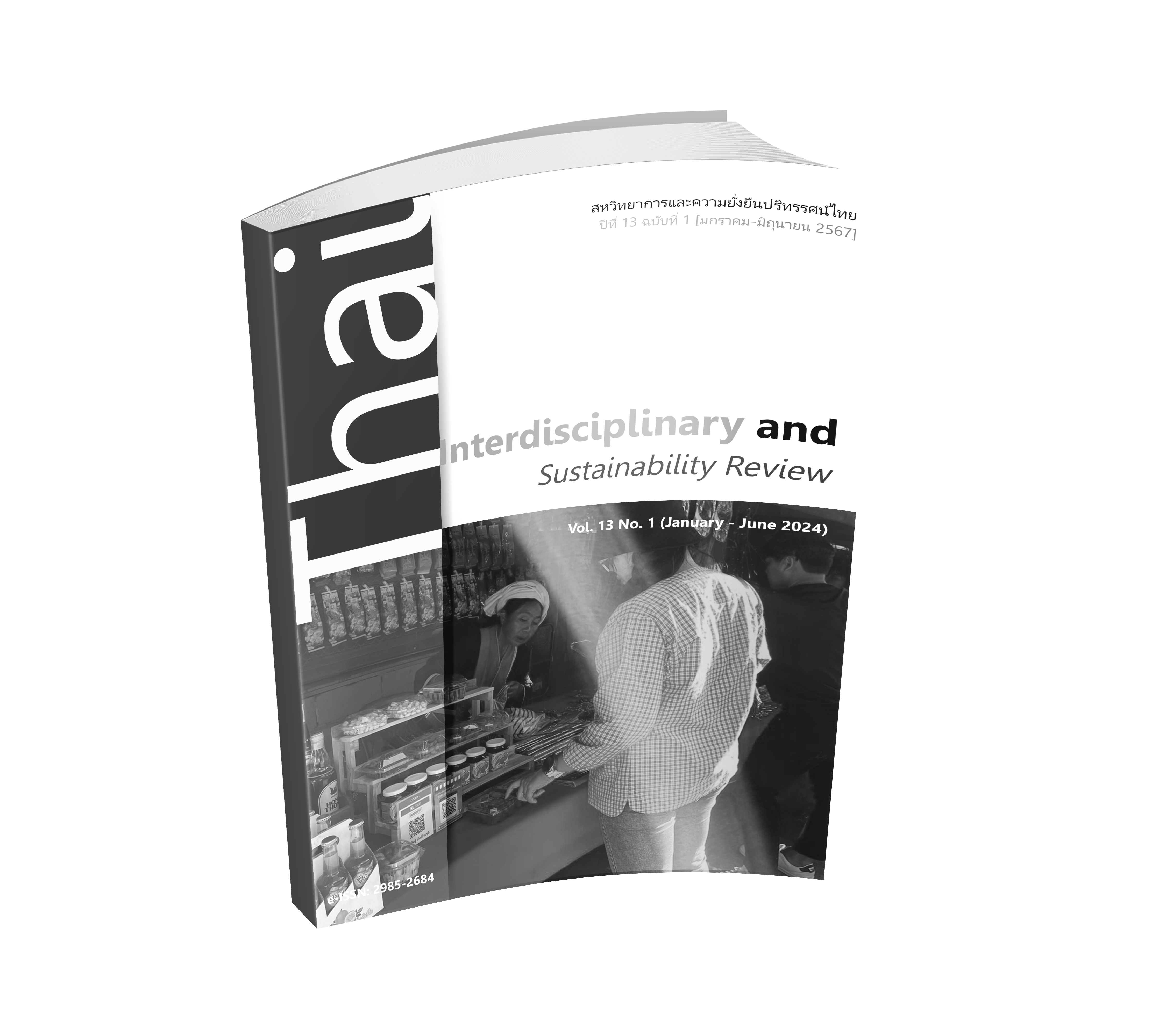TOOLS FOR ANALYZING FINANCIAL STABILITY
DOI:
https://doi.org/10.14456/tisr.2024.15Keywords:
Financial Stability, Firm Value, Risk Assessment, Investment DecisionAbstract
This article aims to present knowledge from a literature review on Financial Stability analysis. It explains the meaning, various concepts, tools used, advantages, and limitations of using tools to forecast Financial Stability. The literature review found that several tools can be used to analyze Financial Stability. Two popular forecasting tools are Altman's Z-Score, which is a financial ratio model, and Tobin's Q which is used to measure value by combining financial and market data. Both tools can be developed into Financial Stability assessments for stakeholders to use in their decision-making. The recommendations from this study are that investors, companies, and data users can apply the knowledge to guide investment and business decisions effectively. Additionally, data users should seek other sources of information to support their decision-making if they want to invest in a business, even after assessing its Financial Stability.
Downloads
References
ตลาดหลักทรัพย์แห่งประเทศไทย. (2562). ข้อมูลการเข้าเหตุอาจถูกเพิกถอนและการพ้นเหตุเพิกถอนจากบริษัทจดทะเบียนในตลาดหลักทรัพย์แห่งประเทศไทย. สืบค้นจาก https://member.set.or.th/th/regulations/simplified_regulations/files/20192525_PossibleDelist_FinancialCondition.pdf.
สลิตตา สาริบุตร, พิมพา หิรัญกิตติ และ อัครวัฒน์ จตุพัฒน์วโรดม. (2561). การพลิกฟื้นธุรกิจ วิสาหกิจขนาดกลางและขนาดย่อมกลุ่มผู้ประกอบการที่มีความเติบโตแบบลดลง (turnaround). RMUTT Global Business and Economics Review, 13(2), 79-100.
Ahmad, N., Shah, F., Ijaz, F., & Ghouri, M. (2023). Corporate income tax, asset turnover and Tobin’s Q as firm performance in Pakistan: Moderating role of liquidity ratio. Cogent Business & Management, 10(1), 2167287.
Al-Sulaiti, K., & Almwajeh, O. (2007). Applying Altman Z-score Model of Bankruptcy on Service Organizations and Its Implications on Marketing Concepts and Strategies. Journal of International Marketing and Marketing Research, 32(2), 59-74.
Altman, E. (1968). Financial Ratios, Discriminant Analysis and the Prediction of Corporate Bankruptcy. The Journal of Finance, 23(4), 589-609.
Anjum, S. (2012). Business bankruptcy prediction models: A significant study of the Altman’s Z-score model. Asian Journal of Management Research, 3(1), 212-219.
Apergis, N., Sorros, J., Artikis, P., & Zisis, V. (2011). Bankruptcy probability and stock prices: The effect of Altman Z-score information on stock prices through panel data. Journal of Modern Accounting and Auditing, 7(7), 689-696.
Beaver, W. (1966). Financial Ratios as Predictors of Failure. Journal of Accounting Research, 4, 71-111.
Bellovary, J., Giacomino, D., & Akers, M. (2007). A Review of Bankruptcy Prediction Studies: 1930 to Present. Journal of Financial Education, 33, 1-42.
Butt, M., Baig, A., & Seyyed, F. (2023). Tobin’s Q Approximation as a Metric of Firm Performance: An Empirical Evaluation. Journal of Strategic Marketing, 31(3), 532-548.
Chancharat, N., & Kumpamool, C. (2022). Working Capital Management, Board Structure and Tobin's Q Ratio of Thai Listed Firms. Managerial Finance, 48(4), 541-556.
Chudson, W. (1945). A Survey of Corporate Financial Structure. In The Pattern of Corporate Financial Structure: A Cross-Section View of Manufacturing, Mining, Trade, and Construction, 1937 (pp. 1-16). Massachusetts: National Bureau of Economic Research.
Chung, K., & Pruitt, S. (1994). A Simple Approximation of Tobin's Q. Financial Management, 23(3), 70-74.
Cihák, M., & Hesse, H. (2010). Islamic Banks and Financial Stability: An Empirical Analysis. Journal of Financial Services Research, 38, 95-113.
Dakhlallh, M., Rashid, N., Abdullah, W., & Al Shehab, H. (2020). Audit Committee and Tobin's Q as a Measure of Firm Performance among Jordanian Companies. Jour of Adv Research in Dynamical & Control Systems, 12(1), 28-41.
Destriwanti, O., Sintha, L., Bertuah, E., & Munandar, A. (2022). Analyzing the Impact of Good Corporate Governance and Financial Performance on Predicting Financial Distress Using the Modified Altman Z Score Model. American International Journal of Business Management, 5(2), 27-36.
Dokiienko, L., Hrynyuk, N., Britchenko, I., Trynchuk, V., & Levchenko, V. (2024). Determinants of Enterprise's Financial Security. Quantitative Finance and Economics, 8(1), 52-74.
Elia, J., Toros, E., Sawaya, C., & Balouza, M. (2021). Using Altman Z”-score to Predict Financial Distress: Evidence from Lebanese Alpha Banks. Management Studies and Economic Systems, 6(1/2), 47-57.
Fedorova, E., Gilenko, E., & Dovzhenko, S. (2013). Bankruptcy Prediction for Russian Companies: Application of Combined Classifiers. Expert Systems with Applications, 40(18), 7285-7293.
Hayes, S., Hodge, K., & Hughes, L. (2010). A Study of the Efficacy of Altman’s Z to Predict Bankruptcy of Specialty Retail Firms Doing Business in Contemporary Times. Economics & Business Journal: Inquiries & Perspectives, 3(1), 130-134.
Jackendoff, N. (1962). A Study of Published Industry Financial and Operating Ratios. Philadelphia: Temple University.
Ko, L., Blocher, E., & Lin, P. (2001). Prediction of Corporate Financial Distress: An Application of the Composite Rule Induction System. The International Journal of Digital Accounting Research, 1(1), 69-85.
Kubayevich, K. (2024). Current Analysis and Current Issues of Ensuring the Financial Stability of the Banking System in Uzbekistan. European Journal of Business Startups and Open Society, 4(3), 169-176.
Mysaka, H., & Derun, I. (2021). Corporate Financial Performance and Tobin’s Q in Dividend and Growth Investing. Contemporary Economics, 15(3), 276-288.
Ng, S., Wong, J., & Zhang, J. (2011). Applying Z-score Model to Distinguish Insolvent Construction Companies in China. Habitat International, 35(4), 599-607.
Ohlson, J. (1980). Financial Ratios and the Probabilistic Prediction of Bankruptcy. Journal of Accounting Research, 18(1), 109-131.
Sareen, A., & Sharma, S. (2022). Assessing Financial Distress and Predicting Stock Prices of Automotive Sector: Robustness of Altman Z-score. Vision, 26(1), 11-24.
Smith, R., & Winakor, A. (1935). Changes in the financial structure of unsuccessful industrial corporations. Illinois: University of Illinois.
Taffler, R. (1983). The Assessment of Company Solvency and Performance Using a Statistical Model. Accounting and Business Research, 13(52), 295-308.
Tobin, J. (1969). A General Equilibrium Approach to Monetary Theory. Journal of Money, Credit and Banking, 1(1), 15-29.
Tung, D., & Phung, V. (2019). An Application of Altman Z-score Model to Analyze the Bankruptcy Risk: Cases of Multidisciplinary Enterprises in Vietnam. Investment Management & Financial Innovations, 16(4), 181-191.
Winaya, G., RM, K., Budiasih, I., & Wiratmaja, I. (2020). Analysis of Altman Z-Score and Zmijewski Bankruptcy Prediction in Telecommunication Sub-Sectors Registered in Indonesia Stock Exchange in 2016-2018. American Journal of Humanities and Social Sciences Research, 4(1), 313-322.
Zhang, G., Hu, M., Patuwo, B., & Indro, D. (1999). Artificial Neural Networks in Bankruptcy Prediction: General Framework and Cross Validation Analysis. European Journal of Operational Research, 116(1), 16-32.

Downloads
Published
How to Cite
Issue
Section
License
Copyright (c) 2024 Authors

This work is licensed under a Creative Commons Attribution-NonCommercial-NoDerivatives 4.0 International License.









.png)


